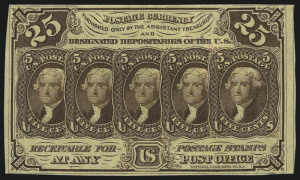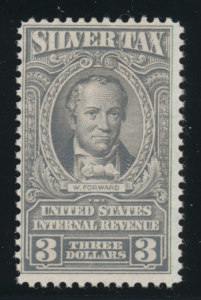Despite the common perception that stamp and coin collecting are very similar, there are very few collectors who do both. Among youngsters, maintaining both types of collections is more customary, but at higher levels, it is very unusual to find people who are passionately devoted to both hobbies. Maybe it is unusual for any specialty collector in any field (say buttons) to be passionate about a seemingly allied collecting field (say, antique sewing thread), but the difference between philately and numismatics seems, to collectors in both fields, to be vast. We philatelists think of ourselves as scholarly and erudite—coin collectors think we are nerdy. And numismatists think of themselves as collecting the most important physical cultural item—coins. We think they are money grubbing, bullion maniacs driven by avarice to a grade crazy hobby (did I cover all our prejudices?). Even the numismatic national collecting society’s name shows their orientation: Their web address is money.org.
There are only a couple of areas where our hobbies intersect. The first is Postage Currency and Encased Postage. Postage Currency has an interesting history and is probably the best example of a crossover hobby item. These bill like instruments were issued during the Civil War as a result of a metal shortage that caused small coins to become quite scarce. Postage Currency was really change (and because it was issued because of a shortage caused by war, it really also qualifies as a kind of early ration coupon) and is collected by philatelists because the paper money illustrated stamps. The stamps on Postage Currency had no postal validity and were put on the bill to encourage the sense that there was something behind the bill except pure fiat. Encased Postage was a more direct approach at using stamps as money. By encasing stamps in a coin like setting, these items really are postage stamps that were passed around like money.
There is one additional area where our hobbies overlap, and this in the Silver Tax revenues of the United States. These revenues were issued to pay taxes on mined silver and, because of the intense bullion interest of numismatists, have always been collected by them as adjunct to their collections. One of the interesting aspects of being a stamp dealer is seeing what kinds of material sells to whom. As we go through our auction bid book, we can pretty much tell what country we are selling, without reference to the lot descriptions, by the ethnic component of the names of the bidders. As you move through the alphabet, you have Chinese bidding on Chinese stamps, Greeks on Greece, and so on. When you get to Silver Tax, Postage Currency, and Encased Postage, you often find completely different names from the traditional philatelic buyers indicating that these lots are selling to coin collectors. There is only one other area like this in US philately. Duck stamps not only sell to stamp collectors; they have an avid following among duck hunters as well.



